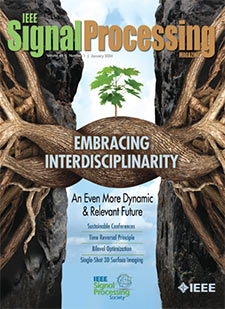- Our Story
- Publications & Resources
- Publications & Resources
- Publications
- IEEE Signal Processing Magazine
- IEEE Journal of Selected Topics in Signal Processing
- IEEE Signal Processing Letters
- IEEE/ACM Transactions on Audio Speech and Language Processing
- IEEE Transactions on Computational Imaging
- IEEE Transactions on Image Processing
- IEEE Transactions on Information Forensics and Security
- IEEE Transactions on Multimedia
- IEEE Transactions on Signal and Information Processing over Networks
- IEEE Transactions on Signal Processing
- IEEE TCI
- IEEE TSIPN
- Data & Challenges
- Submit Manuscript
- Guidelines
- Information for Authors
- Special Issue Deadlines
- Overview Articles
- Top Accessed Articles
- SPS Newsletter
- SigPort
- SPS Resource Center
- Publications Feedback
- Publications FAQ
- Blog
- News
- Dataset Papers
- Conferences & Events
- Community & Involvement
- Professional Development
- For Volunteers
- Information for Authors-OJSP
-
Home
An Exciting Juncture for Signal Processing Research: On Building Bridges, Challenges, and Opportunities
Conferences Events IEEE JSTSP Article IEEE Signal Processing Magazine IEEE TIFS Article IEEE TMM Article IEEE TSP Article Jobs in Signal Processing Lectures Machine Learning Seasonal Schools Signal Processing News SPM Article SPS Distinguished Lectures SPS Newsletter Article SPS Webinar SPS Webinars SPS Webinar Series Webinar webinars -
Our Story
What is Signal Processing?

The technology we use, and even rely on, in our everyday lives –computers, radios, video, cell phones – is enabled by signal processing. Learn More » -
Publications & Resources
-
SPS Resources
- Signal Processing Magazine The premier publication of the society.
- SPS Newsletter Monthly updates in Signal Processing
- SPS Resource Center Online library of tutorials, lectures, and presentations.
- SigPort Online repository for reports, papers, and more.
- SPS Feed The latest news, events, and more from the world of Signal Processing.
-
SPS Resources
-
Conferences & Events
-
Community & Involvement
-
Membership
- Join SPS The IEEE Signal Processing Magazine, Conference, Discounts, Awards, Collaborations, and more!
- Chapter Locator Find your local chapter and connect with fellow industry professionals, academics and students
- Women in Signal Processing Networking and engagement opportunities for women across signal processing disciplines
- Students Scholarships, conference discounts, travel grants, SP Cup, VIP Cup, 5-MICC
- Young Professionals Career development opportunities, networking
- Get Involved
-
Technical Committees
- Applied Signal Processing Systems
- Audio and Acoustic Signal Processing
- Bio Imaging and Signal Processing
- Computational Imaging
- Image Video and Multidimensional Signal Processing
- Information Forensics and Security
- Machine Learning for Signal Processing
- Multimedia Signal Processing
- Sensor Array and Multichannel
- Signal Processing for Communication and Networking
- Signal Processing Theory and Methods
- Speech and Language Processing
- Technical Working Groups
- More TC Resources
-
Membership
-
Professional Development
-
Professional Development
- Mentoring Experiences for Underrepresented Young Researchers (ME-UYR)
- Micro Mentoring Experience Program (MiME)
- Distinguished Lecturer Program
- Distinguished Lecturers
- Distinguished Lecturer Nominations
- Past Lecturers
- Distinguished Industry Speaker Program
- Distinguished Industry Speakers
- Distinguished Industry Speaker Nominations
- Industry Resources
- IEEE Training Materials
- Jobs in Signal Processing: IEEE Job Site
-
Career Resources
- SPS Education Program Educational content in signal processing and related fields.
- Distinguished Lecturer Program Chapters have access to educators and authors in the fields of Signal Processing
- PROGRESS Initiative Promoting diversity in the field of signal processing.
- Job Opportunities Signal Processing and Technical Committee specific job opportunities
- Job Submission Form Employers may submit opportunities in the area of Signal Processing.
-
Professional Development
-
For Volunteers
-
For Board & Committee Members
- Board Agenda/Minutes* Agendas, minutes and supporting documentation for Board and Committee Members
- SPS Directory* Directory of volunteers, society and division directory for Board and Committee Members.
- Membership Development Reports* Insight into the Society’s month-over-month and year-over-year growths and declines for Board and Committee Members
-
For Board & Committee Members
Popular Pages
Today's:
- Submit a Manuscript
- (MLSP 2024) 2024 IEEE International Workshop on Machine Learning for Signal Processing
- Information for Authors
- IEEE Signal Processing Letters
- (SLT 2024) 2024 IEEE Spoken Language Technology Workshop
- SPS Scholarship Program
- IEEE/ACM Transactions on Audio Speech and Language Processing
- IEEE Transactions on Multimedia
- IEEE Transactions on Image Processing
- IEEE Transactions on Information Forensics and Security
- IEEE Signal Processing Magazine
- Conference Call for Papers
- Information for Authors-SPL
- Signal Processing 101
- IEEE Transactions on Signal Processing
All time:
- Information for Authors
- Submit a Manuscript
- IEEE Transactions on Image Processing
- 404 Page
- IEEE/ACM Transactions on Audio Speech and Language Processing
- IEEE Transactions on Information Forensics and Security
- IEEE Transactions on Multimedia
- IEEE Signal Processing Letters
- IEEE Transactions on Signal Processing
- Conferences & Events
- IEEE Journal of Selected Topics in Signal Processing
- Information for Authors-SPL
- Conference Call for Papers
- Signal Processing 101
- IEEE Signal Processing Magazine
Last viewed:
- Through-the-Wall Radar Imaging (2010)
- (MLSP 2024) 2024 IEEE International Workshop on Machine Learning for Signal Processing
- Submit a Manuscript
- Distinguished Industry Speaker Nominations
- (SLT 2024) 2024 IEEE Spoken Language Technology Workshop
- IEEE JSTSP Special Issue on Biometrics at a distance in the Deep Learning era
- Conference Call for Papers
- SPS Scholarship Program
- Our Members
- Volunteer Opportunities
- IEEE Signal Processing Letters
- Community & Involvement
- (SPAWC 2024) 2024 IEEE 25th International Workshop on Signal Processing Advances in Wireless Communications
- Feedback
- (ACSSC 2024) 2024 Asilomar Conference on Signals, Systems, and Computers
What Should We Learn? Special Issue on Data Mining for Cybersecurity
You are here
Newsletter Menu
Newsletter Categories
Top Reasons to Join SPS Today!
1. IEEE Signal Processing Magazine
2. Signal Processing Digital Library*
3. Inside Signal Processing Newsletter
4. SPS Resource Center
5. Career advancement & recognition
6. Discounts on conferences and publications
7. Professional networking
8. Communities for students, young professionals, and women
9. Volunteer opportunities
10. Coming soon! PDH/CEU credits
Click here to learn more.
News and Resources for Members of the IEEE Signal Processing Society
What Should We Learn? Special Issue on Data Mining for Cybersecurity
Computer and communication systems are subject to repeated security attacks. Given the variety of new vulnerabilities discovered every day, the introduction of new attack schemes, and the ever-expanding use of the Internet, it is not surprising that the field of computer and network security has grown and evolved significantly in recent years. Attacks are so pervasive nowadays that many firms, especially large financial institutions, spend over 10% of their total information and communication technology budget directly on computer and network security. Changes in the type of attacks and the identification of new vulnerabilities have resulted in a highly dynamic threat landscape that is unamenable to traditional security approaches.
Data mining techniques that explore data in order to discover hidden patterns and develop predictive models have proven to be effective in tackling the aforementioned information security challenges. In recent years, classification, anomaly detection, and temporal analysis have all been used among other techniques to discover and generalize attack patterns in order to develop powerful solutions for coping with the latest threats.
The articles presented in the special issue published by IEEE Intelligent Systems in March/April 2018 are quite representative of the field of data mining applied to cybersecurity—both in terms of the tasks and domains that they consider and in terms of the solutions that they propose. Specifically, the tasks represented in this issue include user authentication through biometrics, SCADA systems vulnerability assessment, user action identification in IoT encrypted traffic, and network anomaly and intrusion detection in large computer networks as well as in small ones such as car controller networks. In order to address all the issues surveyed in this volume, a plethora of approaches are presented including ensemble methods, one-class classification methods, text mining, transfer learning, data stream mining, and temporal analyses via neural networks. The principal problems tackled by these techniques are problems of reliability, the need to function in different environments, or adaptability to dynamic conditions either due to natural changes to the systems or to adversarial settings.
The articles published in this volume provide both a comprehensive introduction to the types of issues encountered in the field and present sophisticated solution to tackle them. It is an important read for anyone interested in the state-of-the-art in cybersecurity.
Open Calls
Conference News
Society News
- Meet the Candidates: 2019 IEEE Division IX Director-Elect
- One Dollar. Endless Opportunity. Become an SPS Student Member for $1
- Do Not Miss This SPS Late Summer Webinar with Professor Xiao-Ping (Steven) Zhang
- Call for Nominations: Nominations and Appointments Committee and Awards Board
- Job Opportunities in Signal Processing
- New SPS Technical Interest Profile Codes
- Dr. Wing-Kin (Ken) Ma Presents at SPS German Chapter
- Election of Regional Directors-at-Large and Members-at-Large
- Nominations Open for 2018 SPS Awards
TC News
Publications News
Initiatives & Trends
Chapter & DL News
SPS on Twitter
- DEADLINE EXTENDED: The 2023 IEEE International Workshop on Machine Learning for Signal Processing is now accepting… https://t.co/NLH2u19a3y
- ONE MONTH OUT! We are celebrating the inaugural SPS Day on 2 June, honoring the date the Society was established in… https://t.co/V6Z3wKGK1O
- The new SPS Scholarship Program welcomes applications from students interested in pursuing signal processing educat… https://t.co/0aYPMDSWDj
- CALL FOR PAPERS: The IEEE Journal of Selected Topics in Signal Processing is now seeking submissions for a Special… https://t.co/NPCGrSjQbh
- Test your knowledge of signal processing history with our April trivia! Our 75th anniversary celebration continues:… https://t.co/4xal7voFER
Home | Sitemap | Contact | Accessibility | Nondiscrimination Policy | IEEE Ethics Reporting | IEEE Privacy Policy | Terms | Feedback
© Copyright 2024 IEEE – All rights reserved. Use of this website signifies your agreement to the IEEE Terms and Conditions.
A not-for-profit organization, IEEE is the world's largest technical professional organization dedicated to advancing technology for the benefit of humanity.









